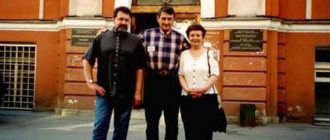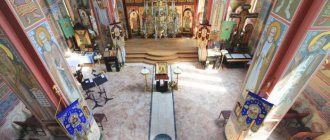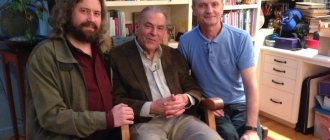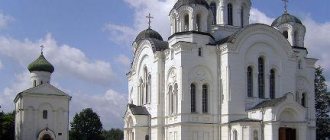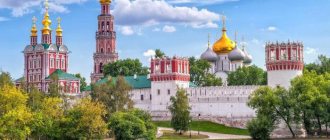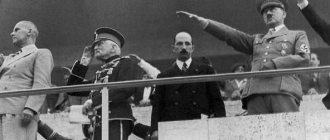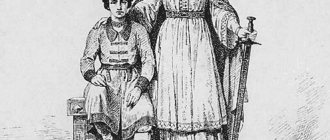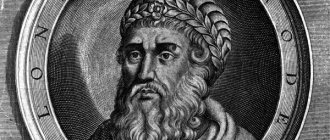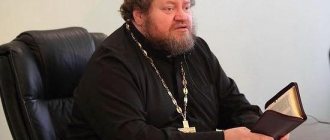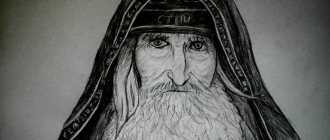| Florensky P.A. |
Pavel Aleksandrovich Florensky
(1882 - 1937), Russian religious philosopher, scientist, priest, follower of V.S. Solovyov Born on January 9, 1882 near the town of Yevlakh (now the territory of present-day Azerbaijan). Father is Russian, a communications engineer. Mother is from an ancient Armenian family that settled in Georgia. The boy was baptized at the insistence of his father in the Orthodox Church in Tiflis, the name was given in honor of the Apostle Paul. The family, which, besides the eldest Pavel, had six more children, lived in isolation. They didn’t talk about religion, they didn’t take the children to church. Pavel graduated from high school with a gold medal. “But everything that I acquired intellectually,” he admitted much later, “was not received from school, but rather in spite of it. Mainly I learned from nature."
At the age of 17, Pavel Florensky experienced a deep spiritual crisis, when he suddenly clearly realized the limitations of physical knowledge and realized that without faith in God, knowledge of the Truth is impossible. In 1904, Florensky brilliantly graduated from the Faculty of Physics and Mathematics of Moscow University.
Then he meets Bishop Anthony (Florensov), who lives in retirement in the Donskoy Monastery, and asks for his blessing to accept monasticism. But the experienced elder advises the young scientist not to rush, but to enter the Moscow Theological Academy to continue his spiritual education and test himself. Florensky moved to Sergiev Posad and for many years connected his life with the Trinity-Sergius Lavra. He graduates from the Academy and then teaches there. Writes books on the philosophy of cult and culture. Here he starts a family, children are born, here he becomes a priest (1911).
From September 1912 to May 1917 he edited the magazine “Theological Bulletin”.
In the first years after the revolution, he worked in the commission for the protection of monuments of art and antiquity of the Trinity-Sergius Lavra. Shortly before the closing of the Lavra and the removal of the relics of St. Sergius, with the blessing of Patriarch Tikhon, together with Count Yuri Alexandrovich Olsufiev, secretly hid the honorable head of the saint.
After the closure of the Lavra, Florensky, as a prominent scientist, was invited to work at the Supreme Economic Council and Glavelektro. Here he makes a number of major scientific discoveries, develops the theory and practice of using semiconductors, and creates a special type of plastic - carbolite - which came to be called “Florensky plastic”. To serve in Soviet institutions, without fear of discontent from the authorities, Father Pavel wears a priestly cassock.
In 1928 he was arrested, but was soon released.
In 1933 he was arrested again.
Father Paul was accused of organizing an alleged monarchist and fascist party. During the investigation, Florensky admitted that he was among the leaders of this party, was its ideologist, and thereby took a significant part of the blame upon himself, he incriminated himself. But in relation to the other accused, he said during interrogations that they did not take any part in the conspiracy (and there were almost 70 people on the investigator’s list), that these were not very capable intellectuals who “were just going to be involved in counter-revolutionary activities, but for now We didn’t have time” [1].
O. Pavel was sentenced to 10 years in the camps and exiled to the Far East.
One of his spiritual daughters, T. A. Schaufus, who became the secretary of the President of Czechoslovakia Tomas Masaryk and died in 1986 in America, appealed through the President of the Czech Republic with a request for Father Pavel to leave the USSR. Permission to leave was obtained, and it was allowed to emigrate with the whole family, but Father Pavel refused, and refused twice. He responded to the first proposal, referring to the words of the Apostle Paul that one must be content with what one has (Phil. 4:11). And the second time he simply asked to stop any hassle regarding leaving.
First, Florensky ends up in the research department of Bamlag, where he studies the problem of construction in permafrost conditions (Many years later, when he will no longer be alive, Norilsk and Surgut will be built using his method). In 1934, Father Pavel was transferred to Solovki. Here he makes more than a dozen scientific discoveries and extracts agar-agar and iodine from seaweed. “Smart iodine” by Pavel Florensky, which today can be bought at any pharmacy, comes from the Solovetsky special purpose camp.
Pavel Florensky was shot on December 8, 1937. Six months earlier, he wrote to his wife: “The task in life is not to live without worries, but to live with dignity and not be an empty place and the ballast of your country...”
In 1959, he was rehabilitated for lack of evidence of a crime.
In his will to his children, Father Pavel wrote: “Try to write down everything you can about the past of the clan, family, home, furnishings of things, books, etc. Try to collect portraits, autographs, letters, printed and handwritten essays of all those who were related to the family. Let the whole history of the family be enshrined in your home and let everything around you be filled with memories.”
. For many years now, the grandson of Father Pavel, Abbot Andronik (Trubachev), has been lovingly and carefully collecting documents, archival materials, eyewitness accounts about Pavel Florensky, and publishing his works. And ten years ago he created a museum in Moscow of his grandfather, priest Pavel Florensky.
When asked why Father Pavel Florensky was not canonized by the Church, Hegumen Andronik (Trubachev) answered this way:
“Currently, the position of the Canonization Commission, which is supported by the Holy Synod, is that a person who pleaded guilty to non-existent crimes is a false witness .
That is, the fact that he admitted himself to be the head of a non-existent political party is his perjury against himself. A huge number of people disagree with this position. People who went through camps and torture say that this is wrong, that the acts of investigators and investigative files cannot be the decisive argument in the matter of canonization. In addition, Florensky’s refusal to leave the camp is an example of Christian deed. The significance of the canonization of Father Paul would be very great: the priest, philosopher and scientist became a martyr. Of course, in Heaven, before God, saints are holy without canonization. But speaking from the point of view of pedagogy, we canonize those people who set an example for our life and creativity. How many saints do we have, when can we tell about their families? Among those canonized, the bulk are monks. The example of Father Paul is important because it convinces: science and religion, knowledge and faith are not mutually exclusive, but complement each other.”
[1].
early years
At the age of 17, Florensky entered Moscow University, where he ended up at the Faculty of Physics and Mathematics. As a student, he met the key poets of the Silver Age: Andrei Bely, Valery Bryusov, Alexander Blok, Konstantin Balmont and others. It was then that Paul became interested in theology. He began to publish in various magazines, for example, in “Scales” and “New Way”.
After graduating from university, Pavel Florensky entered the Moscow Theological Academy. Here he wrote his first serious research work, “The Pillar and Establishment of Thoughts.” For this essay, Florensky received the prestigious Makariev Prize. In 1911, he became a priest and spent the next ten years in Sergiev Posad, where he served in the church of the Red Cross. At this time, Pavel Aleksandrovich Florensky was also an editor at the academic journal “Theological Bulletin”.
Childhood
Pavel Florensky was born on January 9, 1882, within the town of Yevlakh (Azerbaijan).
He was the first child in the family. His father, Alexander Ivanovich, the son of a Russian doctor, served as a communications engineer, building bridges and roads in Transcaucasia. Mother, Olga Pavlovna (Armenian name - Salome), belonged to an ancient Armenian family that at one time settled on Georgian land. During the birth and infancy of his son, the father was engaged in the construction of one of the sections of the railway, and he had to live in freight cars, upholstered with carpets for comfort.
In the fall of 1882, the Florensky family moved to Tiflis. The spouses, despite mutual love, adhered to different religions (Olga Pavlovna was a follower of the Armenian-Gregorian religious movement). Meanwhile, in accordance with the will of the father, the first-born was baptized in the Orthodox Church (according to other sources, by an Orthodox priest at home). The name Paul was given to him in honor of the holy Apostle Paul.
The Florensky family, where six more children were raised in addition to the eldest child, was not distinguished by a strict Christian way of life and did not have the custom of regularly attending temple services. We lived a rather secluded life. Guests rarely disturbed them. Parents willingly engaged in the upbringing and education of their children, but since there were many books in the Florensky house, Pavel had every opportunity to engage in self-education.
Having entered the gymnasium, thanks to his abilities and diligence, he quickly became one of the first students and graduated as a gold medalist. At the same time, as follows from his memoirs, in religious terms he felt like a complete wildard, did not communicate with anyone on theological topics and did not even know how to be baptized correctly.
The Thinker and the Revolution
In 1910, the young man got married. His wife was Anna Mikhailovna Giatsintova (1889–1973), an ordinary girl from a Ryazan peasant family. The couple had five children. The family turned out to be Florensky’s main support, helping him in difficult times that soon awaited the whole country.
The religious thinker considered the onset of the revolution a sign of the apocalypse. Nevertheless, he was not surprised by the events of 1917, since throughout his youth he spoke about the spiritual crisis of Russia and its imminent collapse due to the loss of national and spiritual foundations.
When the Soviet government began to take away the church's property, Florensky began to speak out in defense of key Orthodox churches, including the Trinity-Sergius Lavra. In the 1920s, he received the first denunciations to the Cheka, in which the philosopher was accused of creating a prohibited monarchist circle.
Moral break
At the age of seventeen, Paul seriously realized that without faith, without that higher knowledge taught in the Supernatural Revelation, the Truth cannot be comprehended. During this period he experienced a serious psychological crisis.
In 1899, at night, while sleeping, he suddenly felt as if he were buried alive in the mines, and felt the impossibility of getting out of the darkness. This feeling lasted until a certain mysterious ray brought him the name “God”. Paul took the night phenomenon as an indication that salvation is in God.
Another mysterious incident occurred a little later. Then he was awakened by the force of some unusual spiritual impulse. Jumping out of surprise into the yard, he heard the sound of a loud voice saying his name twice.
Friends and like-minded people
A bright representative of Russian culture of the Silver Age, Florensky had many friends not only among poets and writers, but also among philosophers. Vasily Rozanov, distinguished by his caustic attitude, called him “the Pascal of our time” and “the leader of the young Moscow Slavophilism.” Pavel Florensky was especially close; philosophy attracted many minds and hearts in both capitals to the “Society in Memory of Vl. S. Solovyov." A significant part of his friends belonged to the publishing house “The Path” and the “Circle of Those Seeking Christian Enlightenment.”
Relations with the Soviet authorities
Despite the hard times of revolution and civil war, Pavel Florensky continued to write new theoretical works. In 1918 he completed “Essays on the Philosophy of Cult,” and in 1922, “Iconostasis.” At the same time, the theologian does not forget about his secular specialization and goes to work at Glavenergo. In 1924, his monograph devoted to dielectrics was published. The scientific activity led by Pavel Florensky was actively supported by Leon Trotsky. When the revolutionary fell into disgrace and was deprived of power, his previous connections with the theologian turned out to be a black mark for the latter.
It is noteworthy that Florensky became one of the first persons with a clergy title to begin working in official Soviet institutions. At the same time, he did not renounce his views and hoped that over time Orthodoxy and the new state would find a common language. Moreover, the theologian called on all his scientific colleagues to also get involved in this work - otherwise the cultural agenda will remain in the hands of exclusively proletkultists, he complained.
Working in the field of exact sciences, Pavel Florensky wrote “Imaginaries in Geometry.” In it, the author tried, using mathematical calculations, to refute the heliocentric system of the world proposed by Copernicus. The priest sought to prove the veracity of the idea that the Sun and other objects in the solar system revolve around the Earth.
Disagreements
"Imaginaries in Geometry"
Referring to Dante's Divine Comedy, Florensky opposes Copernicus' heliocentric system. Interprets the Michelson-Morley experiment as proof of the immobility of the Earth. Declares the “notorious experiment of Foucault” fundamentally unsubstantiated. Commenting on Einstein’s special theory of relativity, Florensky comes to the conclusion that beyond the limit of the speed of light, the non-physical “other world” begins. This otherworldly world of imaginary quantities provides a description of the highest eternal reality. Based on the geocentric system, Florensky calculates the distance to this world as the distance at which a body revolving around the Earth in one day will move at the speed of light. Interest in the cosmological model of antiquity is one of the characteristic features of Florensky’s contemporary historical science, which paid great attention to the morphology of space-time of primitive cultures, Antiquity and the Middle Ages.
Antisemitism
In 1913, in Kyiv, a court considered the accusation of the Jew Menachem Beilis for the ritual murder of a 12-year-old student of the Kiev-Sophia Theological School, Andrei Yushchinsky. Without doubting the existence of the practice of ritual murder among Jews, Florensky sent Vasily Rozanov for anonymous publication of the article “Prof. D. A. Khvolson about ritual murders" and "Jews and the fate of Christians." Rozanov included both articles in the book “The Olfactory and Tactile Attitude of Jews to Blood” as an appendix. At the same time, he called anti-Semitism “the greatest sin” and repented that in childhood, out of thoughtlessness, he called a girl a dirty anti-Semitic curse. Florensky’s student Alexei Losev argued in a manuscript censored from “Dialectics of Myth” that, according to God’s plan, in the end the Jews “will all be saved,” although he viewed Judaism as a religion of emptiness - materialism.
Theology
Florensky spoke in the sense that the name of God is God Himself
along with the sounds and letters of that name. In addition, Florensky paid great attention to the magical nature of the word and name.
Florensky wrote in a draft: “It unbearably pains me that the Name-Glorification - the ancient sacred secret of the Church - was taken out into the market place and thrown into the hands of those who should not touch this, and who, by their nature, cannot comprehend it. To school the mysterious thread with which to knit pearls of all dogmas, this means taking her life... Everyone who raised this matter is to blame, and Fr. Hilarion and b. m., o. John of Kronstadt...Christianity is and should be mysterious. As for the outsiders, let them be Protestant... If earlier and now the fate of the movement and dispute depended on me, I would say: “Lord, all this is nonsense. Let’s take care of the salaries of the clergy and epaulets for bishops” - and I would try to direct interests and attention somewhere in the direction ... "
Art critic
In the 1920s Florensky was also involved in museum work and art history. Some of the writer’s works are dedicated to them. He was also a member of the Commission involved in the protection of art monuments of the Trinity-Sergius Lavra. Thanks to the work of this team, which included several other eminent priests and cultural experts, it was possible to describe the huge fund of artifacts of the monastery. The Commission also did not allow the plunder of the national and church property stored in the Lavra.
In the early 1920s. In the country, a campaign to destroy icons and open relics was in full swing. Florensky resisted these actions of the state with all his might. In particular, he wrote the work “Iconostasis”, in which he described in detail the spiritual connection between relics and icons. The publication “Reverse Perspective” was similar in meaning. In these works, the theologian defended the general cultural superiority of icon painting over secular painting. Another challenge for the Church was the massive renaming of streets and cities. Florensky responded to this campaign as well. In "Names" he urged society to stop abandoning its historical and spiritual past.
What else did Pavel Florensky do in those turbulent years? Philosophy, in short, was not his only interest. In 1921, the theologian became a professor at VKHUTEMAS. Higher artistic and technical workshops professed a new course towards constructivism, futurism and technicalism. Florensky, on the contrary, defended the previous forms of culture.
Russian Orthodox Church
December 8, 2012 marked the 75th anniversary of the death of priest Pavel Florensky, a philosopher, theologian, scientist and art critic, in Stalin’s camps. To mark this date, a memorial sign was unveiled in Sergiev Posad on December 5, dedicated to everyone who suffered for their faith during the years of Soviet power. The grandson of the Russian religious philosopher and theologian, a famous researcher of his work, Abbot Andronik (Trubachev), spoke about rarely mentioned episodes of the life of Father Paul, his philosophy and scientific discoveries, and his martyrdom in an interview with a correspondent of the Thomas magazine.
— Father Andronik, Florensky is known to most people as a religious philosopher. How did Father Paul himself think about the relationship between philosophy and religion? Are they in conflict for him, or is there harmony and cooperation between them?
— According to Florensky, philosophy arises from the bosom of religion. Philosophy is an attempt to comprehend and, to some extent, weaken religious life. Intense religious life, in general, does not require such reflection. In general, Florensky believed that everything in human culture arises from religion, on religious grounds. For example, domestication of animals. In order to make religious sacrifices, people needed animals. And so as not to have to run after them through the forest every time, the animals began to be tamed. Or medicine - according to Florensky, it also arose from a religious cult. The first medical institutions appeared at pagan temples. A person came to the temple, received medical help there, was healed, made sacrifices, went to the priest - all at the same time.
But very often the relationship between religion and philosophy is understood as extremely conflicting or as a relationship of disjoint sets. For example, the German philosopher Heidegger believed that religious philosophy is nonsense, something like wooden iron.
For Florensky, on the contrary, philosophy, as its connection with religion strengthens, comes closer to the truth, because it, like everything else, lives by religion and is nourished by its juices. As its connection with religion and religious cult weakens, it truly becomes wooden iron.
— What did Florensky say about the relationship between science and religion? What is the specificity of science compared to religion?
— The specificity, I think, is both in the subject of knowledge and in the ways of knowing the world. There is an artistic way of understanding the world, and there is a scientific one. If science is rooted in religion, it acts not by rational, but by reasonable methods. A purely rationalistic method contradicts the religious path. The reasonable path is rooted in faith. Florensky had his own, completely unique way of knowing. It is difficult to define it. From a philosophical point of view, this is a reliance on intuition, but super-rational, reasonable intuition. Florensky talked about how he once stood at a service, and suddenly he had a vision - the whole life of his friend, the philosopher Vladimir Ern, suddenly seemed to flash before him. Florensky says that he then thought that Ern’s life was over. Then he comes home, and there is a telegram - Ern has died.
This was not occult meditation. The line between occult and spiritual vision is, of course, very thin. The most important thing is that we ourselves cause occult phenomena in ourselves technically. And vision is given from above, apart from the desire and will of a person. It is close to artistic knowledge. Father Pavel told my mother: “I see first of all a thing, its roots, but it is very difficult for me to find a language and a way to show the same thing to people to whom such a path of knowledge is not available or they do not accept it.”
— What do you think of Florensky’s philosophical ideas and works remains relevant today? And what ideas of his, in your opinion, are the main ones in his philosophical work?
— Florensky’s most important position was that we know everything spiritual through its materialization, incarnation. There is nothing spiritual that does not have a material embodiment. Conversely, everything material has a spiritual basis. Here, for example, is a temple. Is this material culture or spiritual? Or a work of literature. What is this, only a spiritual phenomenon, or material too? Connected with this is another important idea of his - the idea of the layering of culture, the symbolization of culture and all existence. The lower layer of existence symbolizes the higher and relies on it.
In the field of art criticism, his greatest achievement is that he began to examine a work of art not only from the point of view of aesthetics, but also from the point of view of technique and technology. I now remember how he described one holy cup of water. First there is a rather boring description of how this or that curl is made on it, and then suddenly the conclusion follows that the author depicted the very idea of water, which seems to shine through this material. Another of his most important ideas, which I have already talked about, is the idea of the origin of culture from a religious cult.
In general, Florensky’s work can be divided into two stages. The first is his theodicy, the justification of God. It is represented by the most famous work of Father Paul among the general public, “The Pillar and Ground of Truth.” The second is the justification of man, anthropodicy (his books “Philosophy of Cult”, “Watersheds of Thought”).
Theodicy, the justification of God, was addressed to the unbelieving intelligentsia. Here answers were given to the following questions: if God is good, then why does evil exist? If God is omnipotent, then why can't he do such and such, etc.?
And Florensky’s anthropodicy, the justification of man, solved, for example, the following problems: if man is the image of God, then why does he not correspond to him in his present state? Why does a person need to strive for holiness, and how can he achieve it?
In general, I must say that most often researchers of Florensky’s work do not agree with each other on a single point. As a rule, everyone sees in him who he himself is. For example, occultists considered him an occultist. The symbolists said that he was a symbolist, etc.
- Why does this happen?
— Father John (Krestyankin) said when they asked him why Florensky’s books contained some descriptions close to the occult, that Florensky wrote about such subtle things for which we do not have the appropriate terminology. He spoke of Florensky’s work as rooted in Orthodoxy.
Father Paul predicted that the twentieth century would be the century of the occult. He had interesting students - Bishop Varnava (Belyaev), Bishop Veniamin (Milov), who wrote that no one except Florensky prepared them for the fact that in the very near future there would be an attack of atheism and occultism on human culture.
After all, it is not enough to say that the occult is very bad, that it is a sin. It is important to understand what human needs it relies on and what it is based on. Does a person have a need to communicate with his dead ancestors? Eat. The Church says that this need is holy and good, that it is realized through prayer and requiem. But if you are a non-church person, then the occult can parasitize on this need. Occultism lives by using the good desires of man given by God. It could not exist if we did not have the need to communicate with our ancestors. Otherwise, our fools would not turn to “sorcerers” and “magicians” through advertisements in newspapers.
Father Paul in his work tried to reveal that good grain on which everything else is built - both good and bad. While exploring pagan religions, he studied them not from the point of view of Christian apologetics, but from the point of view of the fact that light shines in darkness. If for the Jews the coming Christ was revealed through the prophets, then for the pagan world his coming was revealed through false myths and religions. For example, with the myths about the resurrecting Dionysius, about the resurrecting and dying gods, the pagan world was led to the very idea that the Resurrection is possible.
— Father Andronik, many people know that Father Pavel Florensky is a philosopher, theologian and scientist. But not everyone knows that during the First World War he collaborated with Grand Duchess Elizaveta Feodorovna, served in her home church, and even acted as an orderly. Can you tell us more about this period of his life?
— Grand Duchess Florensky was invited to the home church in 1912 through his student Evgeniy Sinadsky, who served in the Marfo-Mariinsky Convent. I assume that it was he who told Elizaveta Fedorovna about Father Pavel. Father Pavel came to Moscow and served the Liturgy at the Martha and Mary Convent. Then, apparently, he also met with the Grand Duchess, and she invited him to be the confessor of the community of Red Cross nurses organized by her at the monastery. Before that, he served in the Annunciation Church near the Trinity-Sergius Lavra. But there he did not develop a relationship with the headman, although Florensky was not the rector. And here there was a unique community: sisters of mercy who had grown old or lost their ability to work. That is, it was not a monastic community, but a sisterhood, because they lived at the monastery as in a hostel.
When World War I began, the sisterhood established an infirmary for the wounded. The population was served free of charge at the outpatient clinic, which bore the name of Grand Duke Sergius. And when Elizaveta Fedorovna began to equip the ambulance train from the Chernigov nobility, Father Pavel asked to accompany him as a priest. He made this trip from early January to March 1915. True, his confessor did not approve of this, because he believed that people who were more fit should do this, and Father Paul’s job was to continue giving lectures. Therefore, he did not go on the second trip. And he performed the duties of an orderly, most likely, because either there were not enough people, or because he had some necessary practical knowledge.
Father Pavel's friendship with Elizaveta Fedorovna continued throughout his tenure in this home church. Some congratulatory notes from the Grand Duchess on Easter have been preserved. She also presented him with an honorary badge of the Red Cross in 1916, and then presented him with a certificate in honor of the 25th anniversary of her acceptance of Orthodoxy. True, Father Pavel did not have many meetings with the Grand Duchess, so he valued them very much and wrote down when these meetings took place.
— Why did Elizaveta Fedorovna become interested in Father Pavel? What could they tell her that was so special?
- Well, what could his student tell about Father Pavel? That he is educated, but of a very strict church orientation, that he is a family man, and that he understands art. Also, it is likely that he does not need money that much, because he has an academic salary, although it was not that big.
— They said about Florensky then that he was almost the only truly believer among the teachers at the Moscow Theological Academy.
- This is a rather emotional point of view. The Academy was heterogeneous, and Bishop Theodore (Pozdeevsky) was sent there as rector not by chance, but in order to, in a sense, churchize the academy, oddly enough. For example, in 1905, students staged strikes there. There were very few professors in office, but there were many Protestant teachers. For example, M.M. Tareev, who said that his “Fundamentals of Christianity” is “my farewell to Christianity.”
— How could Tareev then remain a teacher at the Theological Academy?
- Life is wide... But Father Pavel and Tareev had a strong conflict. There were wonderful professors at the academy, although they were also far from controversial. The same V.O. Klyuchevsky, a wonderful historian, albeit with a positivist bias. He was not a deeply religious person; in history he paid more attention to economic factors. So the academy was very heterogeneous.
— Vasily Vasilyevich Rozanov called Florensky “Russian Pascal.” Why did he call Father Pavel that, and what was the history of their relationship?
“I think Rozanov called Florensky the Russian Pascal because Pascal was a scientist, a mathematician and at the same time a deeply religious man. Rozanov saw in Father Pavel a combination of these same qualities. And their relationship was as follows. Florensky initially read Rozanov's articles around 1903. I wrote a letter, Rozanov answered him. Then, five years later, Rozanov read the first issues of “The Pillar and Statement of Truth.” They began a correspondence. Father Pavel acted towards Rozanov, firstly, as a friend, and, secondly, as a spiritual mentor. In a sense, what Elder Barsanuphius failed in relation to Leo Tolstoy, Father Pavel succeeded in relation to Rozanov.
- Did Rozanov even confess to him?
“I don’t know this, but in his letters to Florensky Rozanov was very frank, telling him a lot about himself, to the horror of his household. Rozanov’s most favorable books towards the Church were written under the influence of Father Paul, although not only. When Rozanov, who was dying of hunger, came to the Lavra, Florensky found him a home here. But Rozanov, in the process of writing “Apocalypse of Our Days,” practically took the path of blasphemy. As a result, friends came to him, including Father Pavel. They gave him an ultimatum that if he did not stop, they would cut off all communication with him. Rozanov got scared and stopped writing Apocalypse. He was generally very timid, as he wrote about himself.
Father Pavel considered Rozanov a brilliant writer, although, of course, they were very different in their views, but that’s not the point. Rozanov had a conflict with the Church on personal and everyday grounds. He was not given a divorce from his first wife, and he seemed to be offended by the Church. Father Pavel said about Rozanov that if the monastery had warmed and fed Rozanov, he would have sung a song about the monastery that no one had ever sung before.
However, they maintained friendship with each other. Now friendship is determined by party interests. If you are a liberal, then the so-called conservative or patriot will not be friends with you. If you are a non-church person, then a church person will also not maintain friendship with you. But Father Pavel sometimes judged views very strictly, but never the person himself. When Andrei Bely became an anthroposophist, he wrote letters to Florensky saying that you probably condemn me. Father Pavel answered him that, of course, I don’t accept anthroposophy and I think that you are confused in it, but I don’t judge you personally.
— This year marks the 90th anniversary of the expulsion of the so-called famous Philosophical Steamship. Why was Pavel Florensky not among the scientists and philosophers expelled from the country by the Soviet government?
“Perhaps the point was that Florensky was never a member of any political parties. Back in 1918, both at lectures and to his students, he said that Soviet power was serious and for a long time. He didn’t support her ideologically, of course, but he didn’t consider it an accidental occurrence that she would now stay for five years and leave. And he made every effort to ensure that he did not leave Russia. Florensky was already offered to go to the Czech Republic in the camp. One of his daughters, after her departure from Russia, became a sister of mercy and looked after the Czech President Masaryk, who knew and loved Russian culture. Masaryk proposed, through the embassy, to organize Florensky’s departure from the camp, and Father Pavel could go to Prague with his entire family. But he wanted to share the fate of his people, because the origins of creativity and life itself, he believed, lie not only in the individual, but also in the people.
In addition, there is also a canonical rule that a priest or pastor must remain with his flock. We will not discuss whether those priests who left Russia were right or wrong. They said that they left with their flock because millions of Russian people emigrated abroad. But for Florensky, his flock remained here. That's how he perceived it.
— Why did he consider it necessary to be loyal to Soviet power?
— Maybe the fact is that for him the option of developing Russia along the bourgeois path was even worse than Bolshevism.
- Why?
- Fuck it... Besides, he saw how many mistakes were made under the tsarist government. Of course, he could not approve of the repressions, but he saw in them, in a sense, God’s providence. After all, political loyalty is subordination to the state forms that have developed. And if you look, the Russian Church has always lived like this. She was always politically loyal, even under the Mongol-Tatars.
— What scientific work did Florensky carry out after the revolution? Is it true that he participated in the work on the GOELRO plan?
— Since 1921, he began working in the Supreme Economic Council system, and in 1925 he joined the staff of the All-Russian Electrochemical Institute, which was one of the leading scientific institutions for the implementation of the GOELRO plan. Father Pavel headed the materials science department at the institute. Then it was necessary to learn how to transmit electricity over long distances. But when transmitting it over long distances, a significant part of the energy is lost. It was necessary to find materials for conductors that would reduce losses. He worked on this problem. His department made several discoveries, some of them patented, some not.
In the first years, the atmosphere in the department was creative. Many friends worked with him. By the 1930s, the atmosphere had become much more difficult: denunciations, crazy plans, mountains of reporting.
— How did your colleagues feel about the fact that a priest was working with them? And did he hide the fact of his priesthood?
— Before his first exile from July to September 1928 to Nizhny Novgorod, he went to work in a cassock, his employees took his blessing, and everyone knew about it. Even when he was expelled, the party cell came out in his defense. She stated that he was a very important world-class scientist, and that many works would be stopped or slowed down by his expulsion.
When his son entered the geological institute, there was an article in Komsomolskaya Pravda that the children of priests enter the institute without competition, while the children of workers cannot get into it. The VEI party cell also stood up for my son.
— Father Pavel also worked on the commission for the protection of monuments of art and antiquities, and, they say, did a lot to preserve the treasures of the Trinity-Sergius Lavra. In addition, the semi-detective story of the rescue of the head of St. Sergius of Radonezh during the ruin of the Lavra by the Bolsheviks is associated with the name of Florensky. Please tell us about this.
— At that time, provincial commissions for the protection of historical monuments were created. Then many estates, monasteries, and churches were closed. But their buildings and property had to be somehow preserved and maintained in order. And a unique situation arose when they created a commission for the protection of the Trinity-Sergius Lavra, which was not provincial, but reported directly to the People’s Commissariat of Education. Florensky became a member of this commission. He understood that the question of what to leave to the Church from its property was not worth it, because everything had already been nationalized. This means that the question is about what can be preserved until the time when it can be returned to the Church.
This commission included a number of famous cultural figures who were believers. There is no doubt that Patriarch Tikhon gave them his blessing for this work, because later they were accused that they were guided not so much by the instructions of the People's Commissariat for Education, but by the recommendations of the Patriarch.
What did they do? They, first of all, described the sacristy of the Trinity-Sergius Lavra, compiled a whole series of inventories of icons, church utensils, silver, etc. Therefore, when the commission to confiscate church valuables arrived, they actually confiscated a lot, but these were mainly objects of the 18th-19th centuries. Everything that was preserved from the 15th-17th centuries was preserved. The recorded inventories did not make it possible to steal anything unattended.
In addition, thanks to the activities of the commission, the head of St. Sergius was preserved. His relics were uncovered in April 1919, while the Lavra was still in operation and services continued. But then, when the brethren were already evicted in November 1919, the Soviet government was faced with the question of what to do with the relics of Sergius of Radonezh. Some suggested simply burying them in a cemetery, others - transporting them to one of the Moscow museums. Believers generally feared that the relics would simply be destroyed. And then, in agreement with the Patriarch and the governor of the Lavra, Archimandrite Karonides, it was decided to try to hide the head of St. Sergius. This was at the end of March 1920. Father Pavel, Yu.A. Olsufiev, as well as S.P., who later became priests. Mansurov and M.V. Shik secretly opened the shrine containing the relics of St. Sergius and removed its head. In its place they put the skull of one of the Trubetskoy princes, buried in the Trinity Cathedral. Then the head of the monk was transferred to Olsufiev’s house, where it was kept in a special casket, which stood like a stand under a palm tree until 1928. In 1928, when arrests began in Sergiev Posad and Olsufiev disappeared, the head was removed and transported to Olsufiev’s new place of residence in Lyubertsy. Only a few people knew where it was kept.
Later she was transported to the village of Vinogradovo along the Savelovskaya road to the temple in honor of the Vladimir Icon of the Mother of God, where Elder Hilarion from Athos served. The chapter was first hidden under the altar in the altar, and then Father Hilarion moved it to the attic of the house where he lived. When the Lavra reopened, Father Hilarion, having told everything to Patriarch Alexy, brought the head of the monk back to the Lavra in 1946. When he re-veiled the relics of St. Sergius to transfer them to the believers, he again put his head in place, and the skull of Prince Trubetskoy was again buried in the Lavra opposite the Spiritual Cathedral.
— But if Father Pavel worked so hard and fruitfully after the revolution, then why was he arrested?
— It was a common broom that swept everyone: priests, former merchants, entrepreneurs, etc. Father Paul was accused of organizing an alleged monarchist and fascist party. During the investigation, Florensky admitted that he was among the leaders of this party, was its ideologist, and thus took a significant part of the blame upon himself.
- Did he incriminate himself?
- Yes, he incriminated himself. But in relation to the other accused, he said during interrogations that they did not take any part in the conspiracy (and there were almost 70 people on the investigator’s list), that these were not very capable intellectuals who were just going to be involved in counter-revolutionary activities, but not yet made it in time.
— Father Pavel made a number of scientific discoveries while already a prisoner of the Solovetsky camp. What kind of discoveries were these, and how was it even possible - scientific activity in a concentration camp?
— The concentration camp was a well-organized production, where everyone, as a rule, was used according to his capabilities. Workers, peasants - dragged wheelbarrows, etc. And scientists could be used to organize camp production or something else. For example, Florensky was first in the Far Eastern camp, and worked there at a research station that studied construction problems in the permafrost zone. The first scientific developments in construction on permafrost were made by the group in which Florensky participated in the scientific work. In 1940, based on the results of their research, a solid scientific work, “Permafrost and Construction on It,” was published. True, Florensky’s name was no longer among the authors.
— What were the conditions in the camp?
— Father Pavel first lived in common barracks along with all the prisoners. In his memoirs, one of his fellow prisoners writes that one day after the bath we came and went to bed, and in the morning I could not raise my head because my hair was frozen to the bunk. Then Florensky was transferred to the research department, there was one common room in which they did mathematical calculations and slept. Then he was transferred to a research station where prisoners worked. Conditions there were better, but they were still under guard. The food there was God knows what, but Florensky wrote home that the food was good, there was no need to send anything, and in general there was a very healthy climate: many prisoners even looked healthier after their troubled Moscow life.
— Did he write from Solovki?
— No, from the Far East. He was very passionate about his scientific work there. It opened up great prospects, because almost half of the Soviet Union, as he wrote in the memo, is located in the permafrost zone. Then they developed the basics of treatment using freezing and made some other scientific discoveries.
When Father Pavel was transferred to Solovki, he spent most of his time creating a plant for the iodine industry. The plant extracted algae and made iodine from it. It was also supposed to make marmalade and various food seasonings from these algae. Then a cheaper method of extracting iodine was discovered, and as a result the plant was liquidated.
— Why was Father Pavel sentenced to death?
— It was a “planned event.” In July 1937, a decision was made that those who received 10 years in the camps and were released should again be arrested and imprisoned in camps. And those who were in the camps under an article that sentenced them to 10 years in prison should have been sentenced to death without any special legal proceedings. As a result of this decision, the Solovetsky camp was supposed to accept about two thousand more prisoners. In this regard, those who were sitting there had to be shot. Several stages were formed. It was difficult to bury two thousand people on Solovki. That's why they were shot on the mainland. According to one version, Florensky was shot in Levashevo, it was a training ground in the Leningrad region like Butovsky. According to another version, he was shot in the vicinity of Lodeynoye Pole.
— Why is Florensky not canonized by the Church?
— Currently, the position of the Canonization Commission, which is supported by the Holy Synod, is that a person who pleaded guilty to non-existent crimes is a perjurer. That is, the fact that he admitted himself to be the head of a non-existent political party is his perjury against himself. A huge number of people disagree with this position. People who went through camps and torture say that this is wrong, that the acts of investigators and investigative files cannot be the decisive argument in the matter of canonization. In addition, Florensky’s refusal to leave the camp is an example of Christian deed.
The significance of the canonization of Father Paul would be very great: the priest, philosopher and scientist became a martyr. Of course, in Heaven, before God, saints are holy without canonization. But speaking from the point of view of pedagogy, we canonize those people who set an example for our life and creativity. How many saints do we have, when can we tell about their families? Among those canonized, the bulk are monks. The example of Father Paul is important because it convinces: science and religion, knowledge and faith are not mutually exclusive, but complement each other.
Interviewed by Yu.V. Pushchaev
Repression and death
Like any other active religious figure, Pavel Aleksandrovich Florensky inevitably stood in the way of the young Soviet state. Repressions against him began in 1928. In the summer, Florensky was sent into exile in Nizhny Novgorod. However, he was soon released thanks to the intercession of Gorky’s wife Ekaterina Peshkova. The thinker had a chance to emigrate abroad, but he did not leave Russia.
In 1933, Florensky was arrested again. This time he was sentenced to ten years in the camps. The charge was the creation of a “national fascist organization”, the Party of Russia.
At first, Pavel Florensky was kept in the Siberian camp “Svobodny”. He began working in the research department at BAMLAG. In 1934, the theologian was sent to Skovorodino in the modern Amur region, where an experimental permafrost station was located. That same autumn he ended up in Solovki. In the famous camp, located on the site of an Orthodox monastery, Florensky worked at an iodine production plant.
The repressed man never managed to be released. In 1937, at the height of the Great Terror, a special troika of the NKVD sentenced him to death. Capital punishment was carried out on November 25 near Leningrad in a place now known as Levashovskaya Pustoshka.
Personal life
In order to become a priest, Paul had to get married or become a monk. The second option was not approved by Pavel Alexandrovich’s spiritual mentor, so the guy should have had a wedding and gotten married. However, for a long time Pavel Florensky was afraid to get married, because he believed that God should come first for him, and if he got married, then the main thing in his life would be his family. One day, when Pavel was thinking about what to do, he remembered his friend’s lonely sister. He married her in a short time.
With his wife Anna Mikhailovna
After a year of marriage, the couple had a son. They named him Vasya . Very quickly the family grew and there were five children. Living together, Pavel and Anna fell in love with each other and together took care of the children they had.
With a family
Theological heritage
One of Florensky’s most famous works, “The Pillar and Ground of Truth” (1914), was his master’s thesis. The core of this essay was the candidate's thesis. It was called “On Religious Truth” (1908). The work was devoted to the paths that lead believers to the Orthodox Church. Florensky considered the main idea of the work to be the idea that dogmas can only be learned through living religious experience. “The Pillar” was written in the genre of theodicy - an attempt to justify God before the human mind, which is in a fallen and sinful state.
The thinker believed that theology and philosophy have common roots. Pavel Florensky, whose books related equally to both of these disciplines, always tried to proceed from this principle in his work. In “The Pillar” the writer exposed in detail numerous heresies (chiliasm, Khlystyism, etc.). He also criticized new ideas that did not correspond to Orthodox canons - such as the “new religious consciousness”, popular among the intelligentsia at the beginning of the 20th century.
"At the watersheds of thought"
A well-founded explanation of the dialectics of the work of priest Pavel Florensky is given by Abbot Andronnik (Trubachev), who notes that the spirit of theodicy by this time was already internally alien to Father Paul - “The Pillar ...”, not yet being published, became a passed stage - and it is no coincidence in the field of spirituality The philosopher's view was originally the Neoplatonist Iamblichus, whose translation and commentary was intended as a master's thesis. “The sacraments of marriage (1910) and the priesthood (1911) were the seeds from which the work of Father Paul was able to grow in a new direction - anthropodicy
».
Florensky's comprehensiveness
The theologian Pavel Florensky, whose biography was connected with a variety of sciences, in his books equally masterfully demonstrated good knowledge in a variety of fields. He skillfully appealed to ancient and modern philosophy, mathematics, philology, and foreign literature.
Florensky’s “pillar” completed the formation of the ontological school at the Moscow Theological Academy. This movement also included Theodore Golubinsky, Serapion Mashkin and other Orthodox theologians. While teaching at the Academy, Florensky taught courses on the history of philosophy. His lectures were devoted to a variety of topics: Plato, Kant, Jewish and Western European thinking, occultism, Christianity, religious culture, etc.
Other features of creativity
As a philosopher, Pavel Florensky, in short, made a great contribution to the understanding of Platonism. This was noted by the unrivaled expert on ancient culture, Alexey Losev. Florensky studied the roots of Platonism, connecting it with philosophical idealism and religion.
In the 1920s the theologian criticized the new concept of man-theism, according to which man is not limited in his activities by the values of outdated religious cults. The writer warned his contemporaries that such ideas, professed in the culture and art of that time, would lead to a shift in the concepts of good and evil.
Power of love
In this book by Pavel Florensky, he notes the unreasonableness of truth, arguing that it is an absolute given and even above reason. The philosopher discusses the core of the concepts of “kindness”, “truth” and “beauty”, coming to the conclusion that they are all based on love. And she is close to lust.
At the same time, Florensky insists on transferring love to the ontological plane from the psychological. A man idealizes his loved one; the priest compares this with icon painting, contrasting it with a caricature that emphasizes only the most negative features.
Coming to the conclusion about the transformative power of love, Florensky goes to the idea of Sophia, the “ideal personality of the world.” In conclusion, he notes that even heroism is valued less than friendship.
